Corporate Finance: Project Analysis and Recommendation Report
VerifiedAdded on 2023/04/24
|9
|3003
|384
Report
AI Summary
This report evaluates a corporate finance project for the Fangio Family Business Enterprise, assessing its financial viability using investment appraisal techniques like NPV, IRR, and payback period. The analysis reveals a positive NPV and a high IRR of 33.48%, indicating a potentially profitable investment. The report includes a detailed cash flow statement, sensitivity analysis focusing on balcony rail sales, and identifies factors the company may have overlooked, such as inflation and qualitative aspects. Recommendations are provided to improve the project's financial performance, emphasizing the importance of accurate cash flow projections and considering external economic factors. The analysis highlights the importance of sensitivity analysis in determining the minimum sales price and volume required for profitability. The report underscores the need for a comprehensive approach to project evaluation, considering both quantitative and qualitative factors for informed decision-making.

Running head: CORPORATE FINANCE
Corporate Finance
Name of the University:
Author’s Note:
Course ID:
Corporate Finance
Name of the University:
Author’s Note:
Course ID:
Paraphrase This Document
Need a fresh take? Get an instant paraphrase of this document with our AI Paraphraser
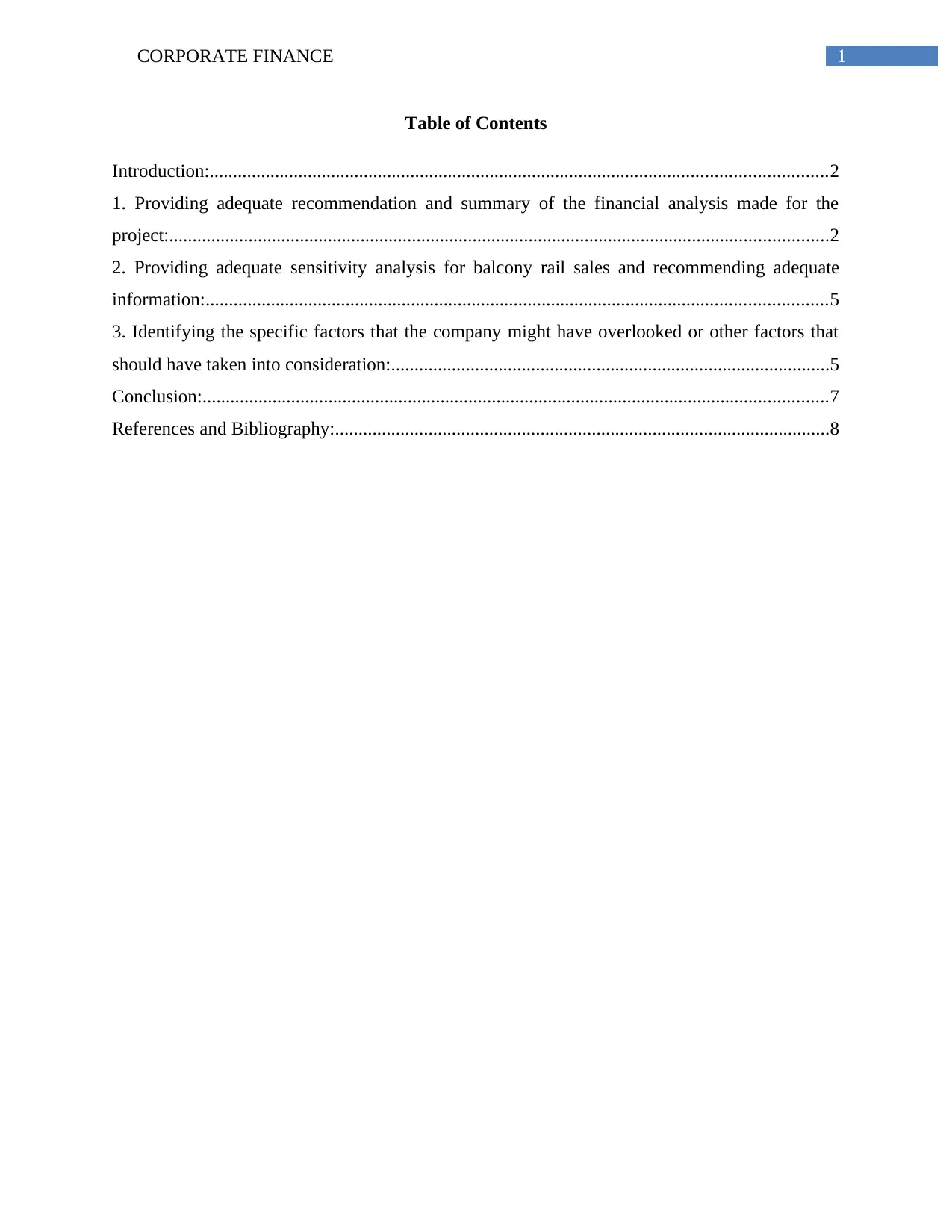
1CORPORATE FINANCE
Table of Contents
Introduction:....................................................................................................................................2
1. Providing adequate recommendation and summary of the financial analysis made for the
project:.............................................................................................................................................2
2. Providing adequate sensitivity analysis for balcony rail sales and recommending adequate
information:.....................................................................................................................................5
3. Identifying the specific factors that the company might have overlooked or other factors that
should have taken into consideration:..............................................................................................5
Conclusion:......................................................................................................................................7
References and Bibliography:..........................................................................................................8
Table of Contents
Introduction:....................................................................................................................................2
1. Providing adequate recommendation and summary of the financial analysis made for the
project:.............................................................................................................................................2
2. Providing adequate sensitivity analysis for balcony rail sales and recommending adequate
information:.....................................................................................................................................5
3. Identifying the specific factors that the company might have overlooked or other factors that
should have taken into consideration:..............................................................................................5
Conclusion:......................................................................................................................................7
References and Bibliography:..........................................................................................................8
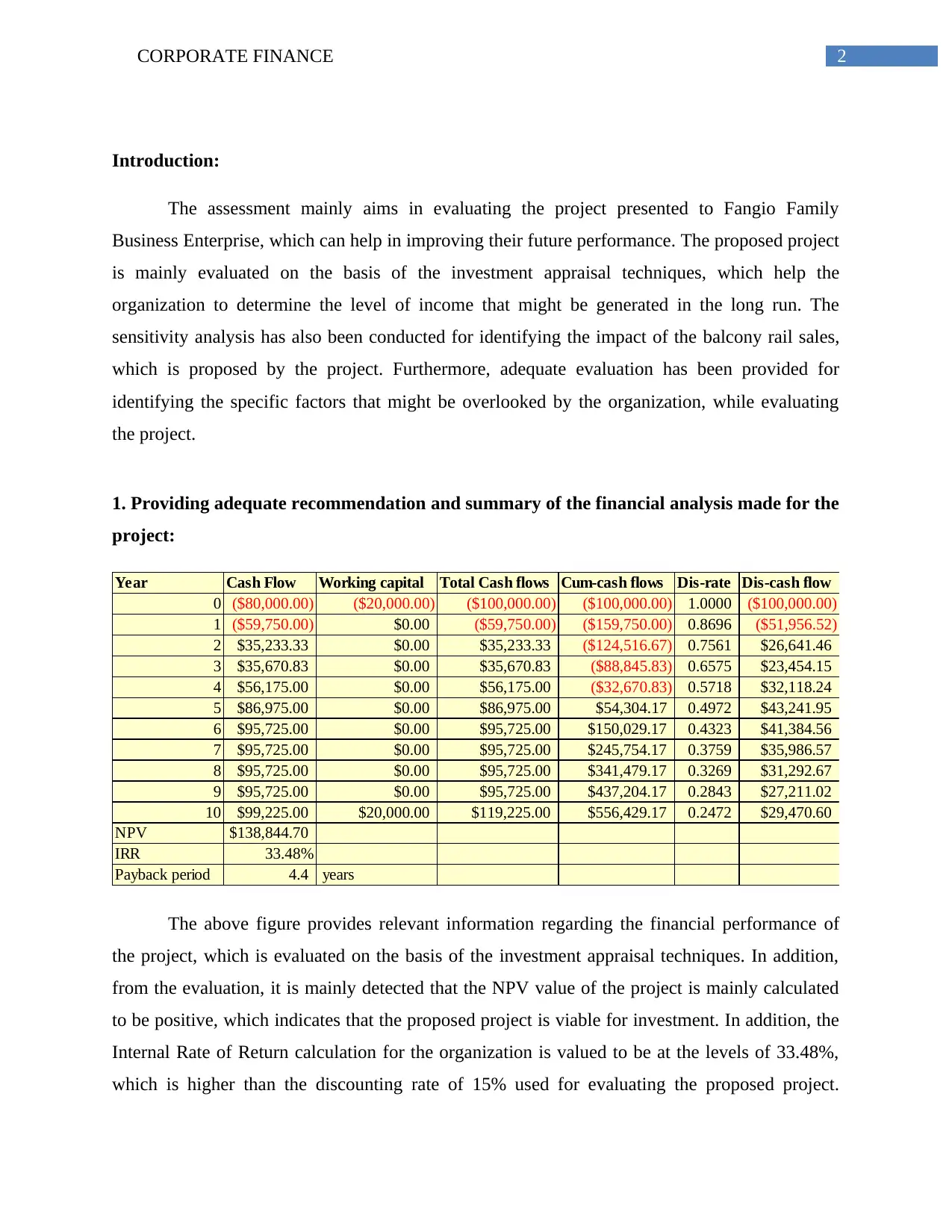
2CORPORATE FINANCE
Introduction:
The assessment mainly aims in evaluating the project presented to Fangio Family
Business Enterprise, which can help in improving their future performance. The proposed project
is mainly evaluated on the basis of the investment appraisal techniques, which help the
organization to determine the level of income that might be generated in the long run. The
sensitivity analysis has also been conducted for identifying the impact of the balcony rail sales,
which is proposed by the project. Furthermore, adequate evaluation has been provided for
identifying the specific factors that might be overlooked by the organization, while evaluating
the project.
1. Providing adequate recommendation and summary of the financial analysis made for the
project:
Year Cash Flow Working capital Total Cash flows Cum-cash flows Dis-rate Dis-cash flow
0 ($80,000.00) ($20,000.00) ($100,000.00) ($100,000.00) 1.0000 ($100,000.00)
1 ($59,750.00) $0.00 ($59,750.00) ($159,750.00) 0.8696 ($51,956.52)
2 $35,233.33 $0.00 $35,233.33 ($124,516.67) 0.7561 $26,641.46
3 $35,670.83 $0.00 $35,670.83 ($88,845.83) 0.6575 $23,454.15
4 $56,175.00 $0.00 $56,175.00 ($32,670.83) 0.5718 $32,118.24
5 $86,975.00 $0.00 $86,975.00 $54,304.17 0.4972 $43,241.95
6 $95,725.00 $0.00 $95,725.00 $150,029.17 0.4323 $41,384.56
7 $95,725.00 $0.00 $95,725.00 $245,754.17 0.3759 $35,986.57
8 $95,725.00 $0.00 $95,725.00 $341,479.17 0.3269 $31,292.67
9 $95,725.00 $0.00 $95,725.00 $437,204.17 0.2843 $27,211.02
10 $99,225.00 $20,000.00 $119,225.00 $556,429.17 0.2472 $29,470.60
NPV $138,844.70
IRR 33.48%
Payback period 4.4 years
The above figure provides relevant information regarding the financial performance of
the project, which is evaluated on the basis of the investment appraisal techniques. In addition,
from the evaluation, it is mainly detected that the NPV value of the project is mainly calculated
to be positive, which indicates that the proposed project is viable for investment. In addition, the
Internal Rate of Return calculation for the organization is valued to be at the levels of 33.48%,
which is higher than the discounting rate of 15% used for evaluating the proposed project.
Introduction:
The assessment mainly aims in evaluating the project presented to Fangio Family
Business Enterprise, which can help in improving their future performance. The proposed project
is mainly evaluated on the basis of the investment appraisal techniques, which help the
organization to determine the level of income that might be generated in the long run. The
sensitivity analysis has also been conducted for identifying the impact of the balcony rail sales,
which is proposed by the project. Furthermore, adequate evaluation has been provided for
identifying the specific factors that might be overlooked by the organization, while evaluating
the project.
1. Providing adequate recommendation and summary of the financial analysis made for the
project:
Year Cash Flow Working capital Total Cash flows Cum-cash flows Dis-rate Dis-cash flow
0 ($80,000.00) ($20,000.00) ($100,000.00) ($100,000.00) 1.0000 ($100,000.00)
1 ($59,750.00) $0.00 ($59,750.00) ($159,750.00) 0.8696 ($51,956.52)
2 $35,233.33 $0.00 $35,233.33 ($124,516.67) 0.7561 $26,641.46
3 $35,670.83 $0.00 $35,670.83 ($88,845.83) 0.6575 $23,454.15
4 $56,175.00 $0.00 $56,175.00 ($32,670.83) 0.5718 $32,118.24
5 $86,975.00 $0.00 $86,975.00 $54,304.17 0.4972 $43,241.95
6 $95,725.00 $0.00 $95,725.00 $150,029.17 0.4323 $41,384.56
7 $95,725.00 $0.00 $95,725.00 $245,754.17 0.3759 $35,986.57
8 $95,725.00 $0.00 $95,725.00 $341,479.17 0.3269 $31,292.67
9 $95,725.00 $0.00 $95,725.00 $437,204.17 0.2843 $27,211.02
10 $99,225.00 $20,000.00 $119,225.00 $556,429.17 0.2472 $29,470.60
NPV $138,844.70
IRR 33.48%
Payback period 4.4 years
The above figure provides relevant information regarding the financial performance of
the project, which is evaluated on the basis of the investment appraisal techniques. In addition,
from the evaluation, it is mainly detected that the NPV value of the project is mainly calculated
to be positive, which indicates that the proposed project is viable for investment. In addition, the
Internal Rate of Return calculation for the organization is valued to be at the levels of 33.48%,
which is higher than the discounting rate of 15% used for evaluating the proposed project.
⊘ This is a preview!⊘
Do you want full access?
Subscribe today to unlock all pages.

Trusted by 1+ million students worldwide
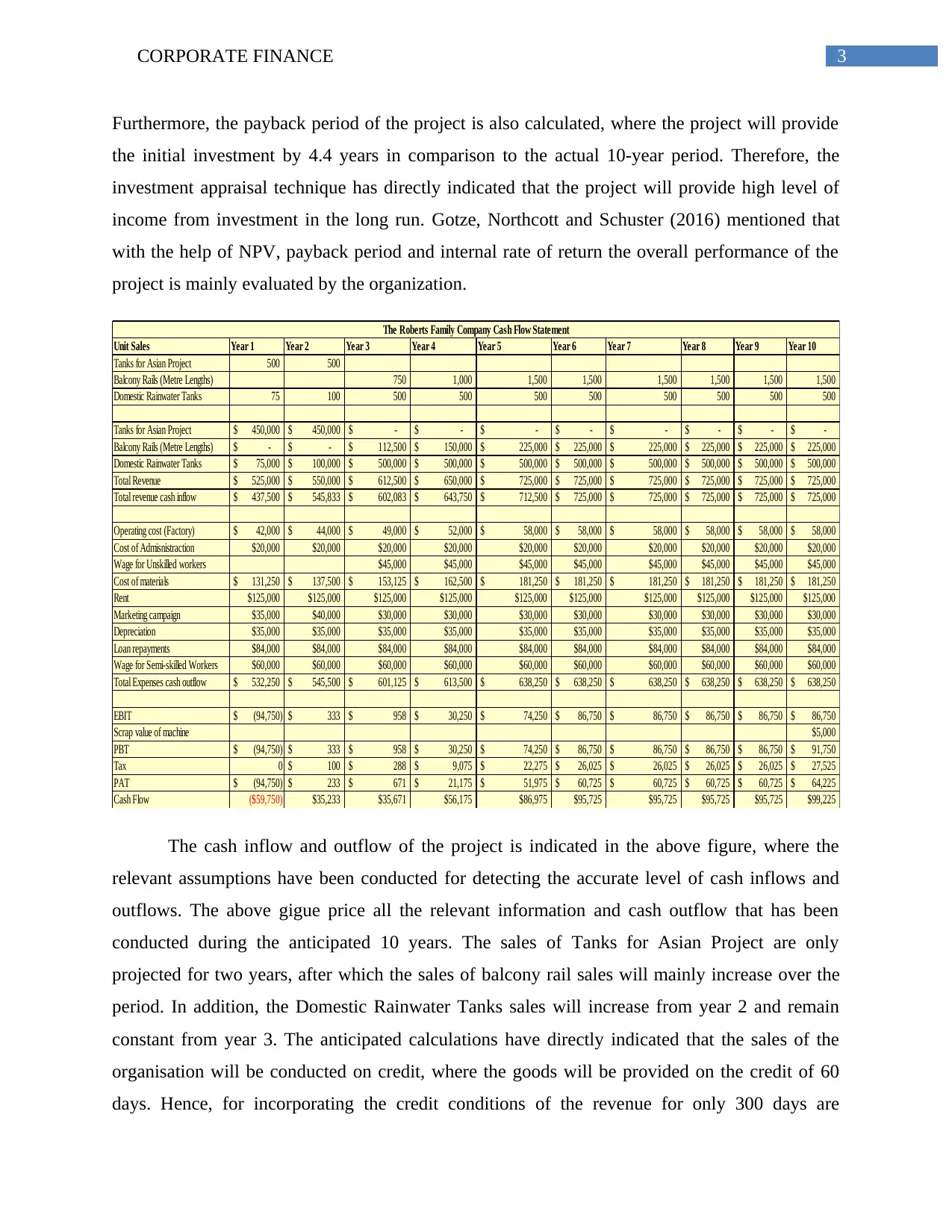
3CORPORATE FINANCE
Furthermore, the payback period of the project is also calculated, where the project will provide
the initial investment by 4.4 years in comparison to the actual 10-year period. Therefore, the
investment appraisal technique has directly indicated that the project will provide high level of
income from investment in the long run. Gotze, Northcott and Schuster (2016) mentioned that
with the help of NPV, payback period and internal rate of return the overall performance of the
project is mainly evaluated by the organization.
Unit Sales Year 1 Year 2 Year 3 Year 4 Year 5 Year 6 Year 7 Year 8 Year 9 Year 10
Tanks for Asian Project 500 500
Balcony Rails (Metre Lengths) 750 1,000 1,500 1,500 1,500 1,500 1,500 1,500
Domestic Rainwater Tanks 75 100 500 500 500 500 500 500 500 500
Tanks for Asian Project 450,000$ 450,000$ -$ -$ -$ -$ -$ -$ -$ -$
Balcony Rails (Metre Lengths) -$ -$ 112,500$ 150,000$ 225,000$ 225,000$ 225,000$ 225,000$ 225,000$ 225,000$
Domestic Rainwater Tanks 75,000$ 100,000$ 500,000$ 500,000$ 500,000$ 500,000$ 500,000$ 500,000$ 500,000$ 500,000$
Total Revenue 525,000$ 550,000$ 612,500$ 650,000$ 725,000$ 725,000$ 725,000$ 725,000$ 725,000$ 725,000$
Total revenue cash inflow 437,500$ 545,833$ 602,083$ 643,750$ 712,500$ 725,000$ 725,000$ 725,000$ 725,000$ 725,000$
Operating cost (Factory) 42,000$ 44,000$ 49,000$ 52,000$ 58,000$ 58,000$ 58,000$ 58,000$ 58,000$ 58,000$
Cost of Admisnistraction $20,000 $20,000 $20,000 $20,000 $20,000 $20,000 $20,000 $20,000 $20,000 $20,000
Wage for Unskilled workers $45,000 $45,000 $45,000 $45,000 $45,000 $45,000 $45,000 $45,000
Cost of materials 131,250$ 137,500$ 153,125$ 162,500$ 181,250$ 181,250$ 181,250$ 181,250$ 181,250$ 181,250$
Rent $125,000 $125,000 $125,000 $125,000 $125,000 $125,000 $125,000 $125,000 $125,000 $125,000
Marketing campaign $35,000 $40,000 $30,000 $30,000 $30,000 $30,000 $30,000 $30,000 $30,000 $30,000
Depreciation $35,000 $35,000 $35,000 $35,000 $35,000 $35,000 $35,000 $35,000 $35,000 $35,000
Loan repayments $84,000 $84,000 $84,000 $84,000 $84,000 $84,000 $84,000 $84,000 $84,000 $84,000
Wage for Semi-skilled Workers $60,000 $60,000 $60,000 $60,000 $60,000 $60,000 $60,000 $60,000 $60,000 $60,000
Total Expenses cash outflow 532,250$ 545,500$ 601,125$ 613,500$ 638,250$ 638,250$ 638,250$ 638,250$ 638,250$ 638,250$
EBIT (94,750)$ 333$ 958$ 30,250$ 74,250$ 86,750$ 86,750$ 86,750$ 86,750$ 86,750$
Scrap value of machine $5,000
PBT (94,750)$ 333$ 958$ 30,250$ 74,250$ 86,750$ 86,750$ 86,750$ 86,750$ 91,750$
Tax 0 100$ 288$ 9,075$ 22,275$ 26,025$ 26,025$ 26,025$ 26,025$ 27,525$
PAT (94,750)$ 233$ 671$ 21,175$ 51,975$ 60,725$ 60,725$ 60,725$ 60,725$ 64,225$
Cash Flow ($59,750) $35,233 $35,671 $56,175 $86,975 $95,725 $95,725 $95,725 $95,725 $99,225
The Roberts Family Company Cash Flow Statement
The cash inflow and outflow of the project is indicated in the above figure, where the
relevant assumptions have been conducted for detecting the accurate level of cash inflows and
outflows. The above gigue price all the relevant information and cash outflow that has been
conducted during the anticipated 10 years. The sales of Tanks for Asian Project are only
projected for two years, after which the sales of balcony rail sales will mainly increase over the
period. In addition, the Domestic Rainwater Tanks sales will increase from year 2 and remain
constant from year 3. The anticipated calculations have directly indicated that the sales of the
organisation will be conducted on credit, where the goods will be provided on the credit of 60
days. Hence, for incorporating the credit conditions of the revenue for only 300 days are
Furthermore, the payback period of the project is also calculated, where the project will provide
the initial investment by 4.4 years in comparison to the actual 10-year period. Therefore, the
investment appraisal technique has directly indicated that the project will provide high level of
income from investment in the long run. Gotze, Northcott and Schuster (2016) mentioned that
with the help of NPV, payback period and internal rate of return the overall performance of the
project is mainly evaluated by the organization.
Unit Sales Year 1 Year 2 Year 3 Year 4 Year 5 Year 6 Year 7 Year 8 Year 9 Year 10
Tanks for Asian Project 500 500
Balcony Rails (Metre Lengths) 750 1,000 1,500 1,500 1,500 1,500 1,500 1,500
Domestic Rainwater Tanks 75 100 500 500 500 500 500 500 500 500
Tanks for Asian Project 450,000$ 450,000$ -$ -$ -$ -$ -$ -$ -$ -$
Balcony Rails (Metre Lengths) -$ -$ 112,500$ 150,000$ 225,000$ 225,000$ 225,000$ 225,000$ 225,000$ 225,000$
Domestic Rainwater Tanks 75,000$ 100,000$ 500,000$ 500,000$ 500,000$ 500,000$ 500,000$ 500,000$ 500,000$ 500,000$
Total Revenue 525,000$ 550,000$ 612,500$ 650,000$ 725,000$ 725,000$ 725,000$ 725,000$ 725,000$ 725,000$
Total revenue cash inflow 437,500$ 545,833$ 602,083$ 643,750$ 712,500$ 725,000$ 725,000$ 725,000$ 725,000$ 725,000$
Operating cost (Factory) 42,000$ 44,000$ 49,000$ 52,000$ 58,000$ 58,000$ 58,000$ 58,000$ 58,000$ 58,000$
Cost of Admisnistraction $20,000 $20,000 $20,000 $20,000 $20,000 $20,000 $20,000 $20,000 $20,000 $20,000
Wage for Unskilled workers $45,000 $45,000 $45,000 $45,000 $45,000 $45,000 $45,000 $45,000
Cost of materials 131,250$ 137,500$ 153,125$ 162,500$ 181,250$ 181,250$ 181,250$ 181,250$ 181,250$ 181,250$
Rent $125,000 $125,000 $125,000 $125,000 $125,000 $125,000 $125,000 $125,000 $125,000 $125,000
Marketing campaign $35,000 $40,000 $30,000 $30,000 $30,000 $30,000 $30,000 $30,000 $30,000 $30,000
Depreciation $35,000 $35,000 $35,000 $35,000 $35,000 $35,000 $35,000 $35,000 $35,000 $35,000
Loan repayments $84,000 $84,000 $84,000 $84,000 $84,000 $84,000 $84,000 $84,000 $84,000 $84,000
Wage for Semi-skilled Workers $60,000 $60,000 $60,000 $60,000 $60,000 $60,000 $60,000 $60,000 $60,000 $60,000
Total Expenses cash outflow 532,250$ 545,500$ 601,125$ 613,500$ 638,250$ 638,250$ 638,250$ 638,250$ 638,250$ 638,250$
EBIT (94,750)$ 333$ 958$ 30,250$ 74,250$ 86,750$ 86,750$ 86,750$ 86,750$ 86,750$
Scrap value of machine $5,000
PBT (94,750)$ 333$ 958$ 30,250$ 74,250$ 86,750$ 86,750$ 86,750$ 86,750$ 91,750$
Tax 0 100$ 288$ 9,075$ 22,275$ 26,025$ 26,025$ 26,025$ 26,025$ 27,525$
PAT (94,750)$ 233$ 671$ 21,175$ 51,975$ 60,725$ 60,725$ 60,725$ 60,725$ 64,225$
Cash Flow ($59,750) $35,233 $35,671 $56,175 $86,975 $95,725 $95,725 $95,725 $95,725 $99,225
The Roberts Family Company Cash Flow Statement
The cash inflow and outflow of the project is indicated in the above figure, where the
relevant assumptions have been conducted for detecting the accurate level of cash inflows and
outflows. The above gigue price all the relevant information and cash outflow that has been
conducted during the anticipated 10 years. The sales of Tanks for Asian Project are only
projected for two years, after which the sales of balcony rail sales will mainly increase over the
period. In addition, the Domestic Rainwater Tanks sales will increase from year 2 and remain
constant from year 3. The anticipated calculations have directly indicated that the sales of the
organisation will be conducted on credit, where the goods will be provided on the credit of 60
days. Hence, for incorporating the credit conditions of the revenue for only 300 days are
Paraphrase This Document
Need a fresh take? Get an instant paraphrase of this document with our AI Paraphraser

4CORPORATE FINANCE
considered one first year and for next year the 60 days revenue from year-1 and 300-days
revenue from year 2 is mainly used for determining the cash inflows of the project. The
anticipations have mainly altered the level of cash inflows of the project, which can eventually
help in improving the level of income from investment.
The relevant expenses of the project have also been considered for identifying the cash
outflows that has been conducted for the proposed project. The factory operating cost of
anticipated to be 8%, as depicted in the project, whereas the overall administrative cost is
considered be $20,000, where the material cost is 25% of the sales value. The expenses directly
indicate that the financial performance of the project, which can help in understanding the level
of income from operations. Furthermore, the evaluation has mainly indicated a constant rent that
needs to be provided by the organisation for successfully completing the project. The marketing
campaign is also used for detecting cost, which will be incurred for raising demand for its
products. In addition, the specific interest rate has been calculated for each year for determining
the cash outflows of the project. The repayment of loan is also evaluated to detect the total cash
outflows, which has been generated during the financial year. The interest paid by the
organisation is considered under the taxable income, whereas the repayment is not considered
under taxable measure (Throsby 2016).
The expenses conducted in semi-skilled workers are conducted for each year, while the
unskilled workers expenses start from third year of the project due to the commencement of
balcony rail sales. The depreciation considered for the machinery is mainly calculated on the
basis of the total expenses on machine and number of years needed for operations. After
detecting all the relevant expenses from income, the actual taxes and profit after tax is
determined. In addition, the loan repayment has helped in detecting the actual income from
operations. Therefore, it can be understood that the cash flow of the project has increased
initially over the period of the project year. This has mainly helped in detecting the level of
income from operations, which can help in generating high level of income from operations.
Harris (2017) stated that investment appraisal techniques can be used for understanding the
financial performance of the proposed project.
considered one first year and for next year the 60 days revenue from year-1 and 300-days
revenue from year 2 is mainly used for determining the cash inflows of the project. The
anticipations have mainly altered the level of cash inflows of the project, which can eventually
help in improving the level of income from investment.
The relevant expenses of the project have also been considered for identifying the cash
outflows that has been conducted for the proposed project. The factory operating cost of
anticipated to be 8%, as depicted in the project, whereas the overall administrative cost is
considered be $20,000, where the material cost is 25% of the sales value. The expenses directly
indicate that the financial performance of the project, which can help in understanding the level
of income from operations. Furthermore, the evaluation has mainly indicated a constant rent that
needs to be provided by the organisation for successfully completing the project. The marketing
campaign is also used for detecting cost, which will be incurred for raising demand for its
products. In addition, the specific interest rate has been calculated for each year for determining
the cash outflows of the project. The repayment of loan is also evaluated to detect the total cash
outflows, which has been generated during the financial year. The interest paid by the
organisation is considered under the taxable income, whereas the repayment is not considered
under taxable measure (Throsby 2016).
The expenses conducted in semi-skilled workers are conducted for each year, while the
unskilled workers expenses start from third year of the project due to the commencement of
balcony rail sales. The depreciation considered for the machinery is mainly calculated on the
basis of the total expenses on machine and number of years needed for operations. After
detecting all the relevant expenses from income, the actual taxes and profit after tax is
determined. In addition, the loan repayment has helped in detecting the actual income from
operations. Therefore, it can be understood that the cash flow of the project has increased
initially over the period of the project year. This has mainly helped in detecting the level of
income from operations, which can help in generating high level of income from operations.
Harris (2017) stated that investment appraisal techniques can be used for understanding the
financial performance of the proposed project.
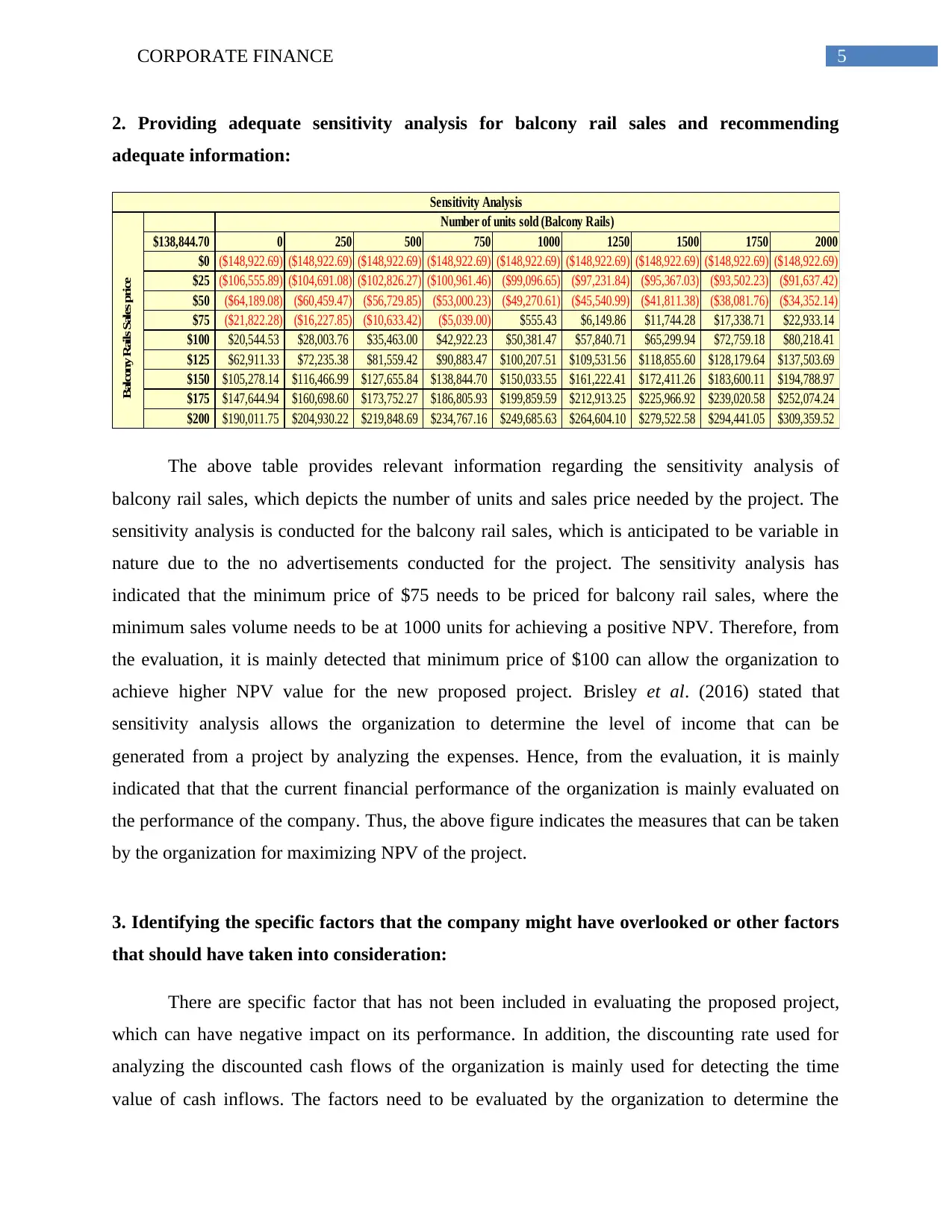
5CORPORATE FINANCE
2. Providing adequate sensitivity analysis for balcony rail sales and recommending
adequate information:
$138,844.70 0 250 500 750 1000 1250 1500 1750 2000
$0 ($148,922.69) ($148,922.69) ($148,922.69) ($148,922.69) ($148,922.69) ($148,922.69) ($148,922.69) ($148,922.69) ($148,922.69)
$25 ($106,555.89) ($104,691.08) ($102,826.27) ($100,961.46) ($99,096.65) ($97,231.84) ($95,367.03) ($93,502.23) ($91,637.42)
$50 ($64,189.08) ($60,459.47) ($56,729.85) ($53,000.23) ($49,270.61) ($45,540.99) ($41,811.38) ($38,081.76) ($34,352.14)
$75 ($21,822.28) ($16,227.85) ($10,633.42) ($5,039.00) $555.43 $6,149.86 $11,744.28 $17,338.71 $22,933.14
$100 $20,544.53 $28,003.76 $35,463.00 $42,922.23 $50,381.47 $57,840.71 $65,299.94 $72,759.18 $80,218.41
$125 $62,911.33 $72,235.38 $81,559.42 $90,883.47 $100,207.51 $109,531.56 $118,855.60 $128,179.64 $137,503.69
$150 $105,278.14 $116,466.99 $127,655.84 $138,844.70 $150,033.55 $161,222.41 $172,411.26 $183,600.11 $194,788.97
$175 $147,644.94 $160,698.60 $173,752.27 $186,805.93 $199,859.59 $212,913.25 $225,966.92 $239,020.58 $252,074.24
$200 $190,011.75 $204,930.22 $219,848.69 $234,767.16 $249,685.63 $264,604.10 $279,522.58 $294,441.05 $309,359.52
Number of units sold (Balcony Rails)
Sensitivity Analysis
Balcony Rails Sales price
The above table provides relevant information regarding the sensitivity analysis of
balcony rail sales, which depicts the number of units and sales price needed by the project. The
sensitivity analysis is conducted for the balcony rail sales, which is anticipated to be variable in
nature due to the no advertisements conducted for the project. The sensitivity analysis has
indicated that the minimum price of $75 needs to be priced for balcony rail sales, where the
minimum sales volume needs to be at 1000 units for achieving a positive NPV. Therefore, from
the evaluation, it is mainly detected that minimum price of $100 can allow the organization to
achieve higher NPV value for the new proposed project. Brisley et al. (2016) stated that
sensitivity analysis allows the organization to determine the level of income that can be
generated from a project by analyzing the expenses. Hence, from the evaluation, it is mainly
indicated that that the current financial performance of the organization is mainly evaluated on
the performance of the company. Thus, the above figure indicates the measures that can be taken
by the organization for maximizing NPV of the project.
3. Identifying the specific factors that the company might have overlooked or other factors
that should have taken into consideration:
There are specific factor that has not been included in evaluating the proposed project,
which can have negative impact on its performance. In addition, the discounting rate used for
analyzing the discounted cash flows of the organization is mainly used for detecting the time
value of cash inflows. The factors need to be evaluated by the organization to determine the
2. Providing adequate sensitivity analysis for balcony rail sales and recommending
adequate information:
$138,844.70 0 250 500 750 1000 1250 1500 1750 2000
$0 ($148,922.69) ($148,922.69) ($148,922.69) ($148,922.69) ($148,922.69) ($148,922.69) ($148,922.69) ($148,922.69) ($148,922.69)
$25 ($106,555.89) ($104,691.08) ($102,826.27) ($100,961.46) ($99,096.65) ($97,231.84) ($95,367.03) ($93,502.23) ($91,637.42)
$50 ($64,189.08) ($60,459.47) ($56,729.85) ($53,000.23) ($49,270.61) ($45,540.99) ($41,811.38) ($38,081.76) ($34,352.14)
$75 ($21,822.28) ($16,227.85) ($10,633.42) ($5,039.00) $555.43 $6,149.86 $11,744.28 $17,338.71 $22,933.14
$100 $20,544.53 $28,003.76 $35,463.00 $42,922.23 $50,381.47 $57,840.71 $65,299.94 $72,759.18 $80,218.41
$125 $62,911.33 $72,235.38 $81,559.42 $90,883.47 $100,207.51 $109,531.56 $118,855.60 $128,179.64 $137,503.69
$150 $105,278.14 $116,466.99 $127,655.84 $138,844.70 $150,033.55 $161,222.41 $172,411.26 $183,600.11 $194,788.97
$175 $147,644.94 $160,698.60 $173,752.27 $186,805.93 $199,859.59 $212,913.25 $225,966.92 $239,020.58 $252,074.24
$200 $190,011.75 $204,930.22 $219,848.69 $234,767.16 $249,685.63 $264,604.10 $279,522.58 $294,441.05 $309,359.52
Number of units sold (Balcony Rails)
Sensitivity Analysis
Balcony Rails Sales price
The above table provides relevant information regarding the sensitivity analysis of
balcony rail sales, which depicts the number of units and sales price needed by the project. The
sensitivity analysis is conducted for the balcony rail sales, which is anticipated to be variable in
nature due to the no advertisements conducted for the project. The sensitivity analysis has
indicated that the minimum price of $75 needs to be priced for balcony rail sales, where the
minimum sales volume needs to be at 1000 units for achieving a positive NPV. Therefore, from
the evaluation, it is mainly detected that minimum price of $100 can allow the organization to
achieve higher NPV value for the new proposed project. Brisley et al. (2016) stated that
sensitivity analysis allows the organization to determine the level of income that can be
generated from a project by analyzing the expenses. Hence, from the evaluation, it is mainly
indicated that that the current financial performance of the organization is mainly evaluated on
the performance of the company. Thus, the above figure indicates the measures that can be taken
by the organization for maximizing NPV of the project.
3. Identifying the specific factors that the company might have overlooked or other factors
that should have taken into consideration:
There are specific factor that has not been included in evaluating the proposed project,
which can have negative impact on its performance. In addition, the discounting rate used for
analyzing the discounted cash flows of the organization is mainly used for detecting the time
value of cash inflows. The factors need to be evaluated by the organization to determine the
⊘ This is a preview!⊘
Do you want full access?
Subscribe today to unlock all pages.

Trusted by 1+ million students worldwide
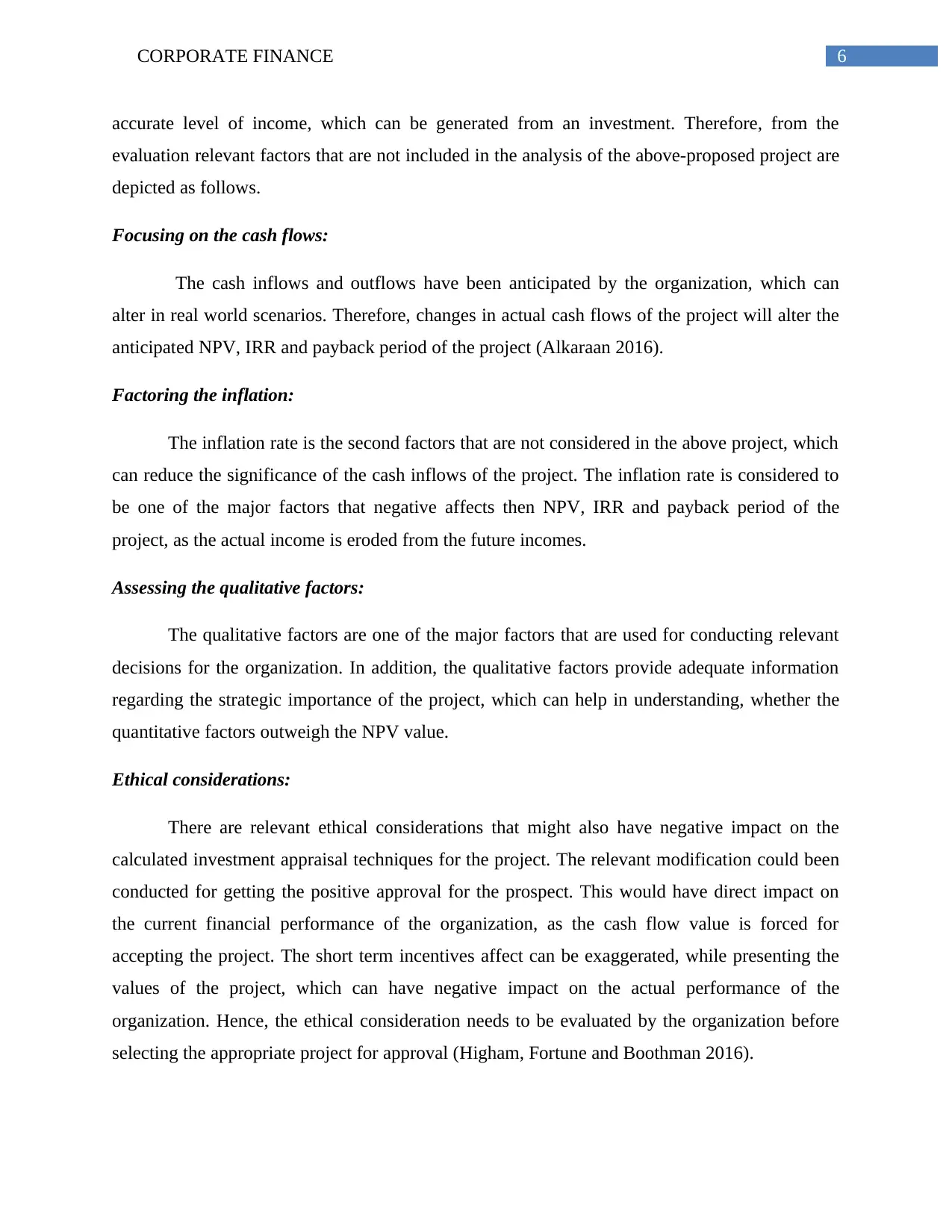
6CORPORATE FINANCE
accurate level of income, which can be generated from an investment. Therefore, from the
evaluation relevant factors that are not included in the analysis of the above-proposed project are
depicted as follows.
Focusing on the cash flows:
The cash inflows and outflows have been anticipated by the organization, which can
alter in real world scenarios. Therefore, changes in actual cash flows of the project will alter the
anticipated NPV, IRR and payback period of the project (Alkaraan 2016).
Factoring the inflation:
The inflation rate is the second factors that are not considered in the above project, which
can reduce the significance of the cash inflows of the project. The inflation rate is considered to
be one of the major factors that negative affects then NPV, IRR and payback period of the
project, as the actual income is eroded from the future incomes.
Assessing the qualitative factors:
The qualitative factors are one of the major factors that are used for conducting relevant
decisions for the organization. In addition, the qualitative factors provide adequate information
regarding the strategic importance of the project, which can help in understanding, whether the
quantitative factors outweigh the NPV value.
Ethical considerations:
There are relevant ethical considerations that might also have negative impact on the
calculated investment appraisal techniques for the project. The relevant modification could been
conducted for getting the positive approval for the prospect. This would have direct impact on
the current financial performance of the organization, as the cash flow value is forced for
accepting the project. The short term incentives affect can be exaggerated, while presenting the
values of the project, which can have negative impact on the actual performance of the
organization. Hence, the ethical consideration needs to be evaluated by the organization before
selecting the appropriate project for approval (Higham, Fortune and Boothman 2016).
accurate level of income, which can be generated from an investment. Therefore, from the
evaluation relevant factors that are not included in the analysis of the above-proposed project are
depicted as follows.
Focusing on the cash flows:
The cash inflows and outflows have been anticipated by the organization, which can
alter in real world scenarios. Therefore, changes in actual cash flows of the project will alter the
anticipated NPV, IRR and payback period of the project (Alkaraan 2016).
Factoring the inflation:
The inflation rate is the second factors that are not considered in the above project, which
can reduce the significance of the cash inflows of the project. The inflation rate is considered to
be one of the major factors that negative affects then NPV, IRR and payback period of the
project, as the actual income is eroded from the future incomes.
Assessing the qualitative factors:
The qualitative factors are one of the major factors that are used for conducting relevant
decisions for the organization. In addition, the qualitative factors provide adequate information
regarding the strategic importance of the project, which can help in understanding, whether the
quantitative factors outweigh the NPV value.
Ethical considerations:
There are relevant ethical considerations that might also have negative impact on the
calculated investment appraisal techniques for the project. The relevant modification could been
conducted for getting the positive approval for the prospect. This would have direct impact on
the current financial performance of the organization, as the cash flow value is forced for
accepting the project. The short term incentives affect can be exaggerated, while presenting the
values of the project, which can have negative impact on the actual performance of the
organization. Hence, the ethical consideration needs to be evaluated by the organization before
selecting the appropriate project for approval (Higham, Fortune and Boothman 2016).
Paraphrase This Document
Need a fresh take? Get an instant paraphrase of this document with our AI Paraphraser

7CORPORATE FINANCE
Conclusion:
The assessment directly evaluates the financial performance of the proposed project,
which is positive and depicts the high possible income that can be generated from investment. In
addition, the investment appraisal technique has mainly indicated that the proposed project is a
viable investment approach, which can generate high level of income for the organization. The
sensitivity analysis has also indicated the level of cost and sales units that needs to be conducted
by the organization for achieving a positive NPV value. Furthermore, the evaluation has also
indicated that different level of factors that needs to be considered by the organization before
making relevant investment decisions.
Conclusion:
The assessment directly evaluates the financial performance of the proposed project,
which is positive and depicts the high possible income that can be generated from investment. In
addition, the investment appraisal technique has mainly indicated that the proposed project is a
viable investment approach, which can generate high level of income for the organization. The
sensitivity analysis has also indicated the level of cost and sales units that needs to be conducted
by the organization for achieving a positive NPV value. Furthermore, the evaluation has also
indicated that different level of factors that needs to be considered by the organization before
making relevant investment decisions.
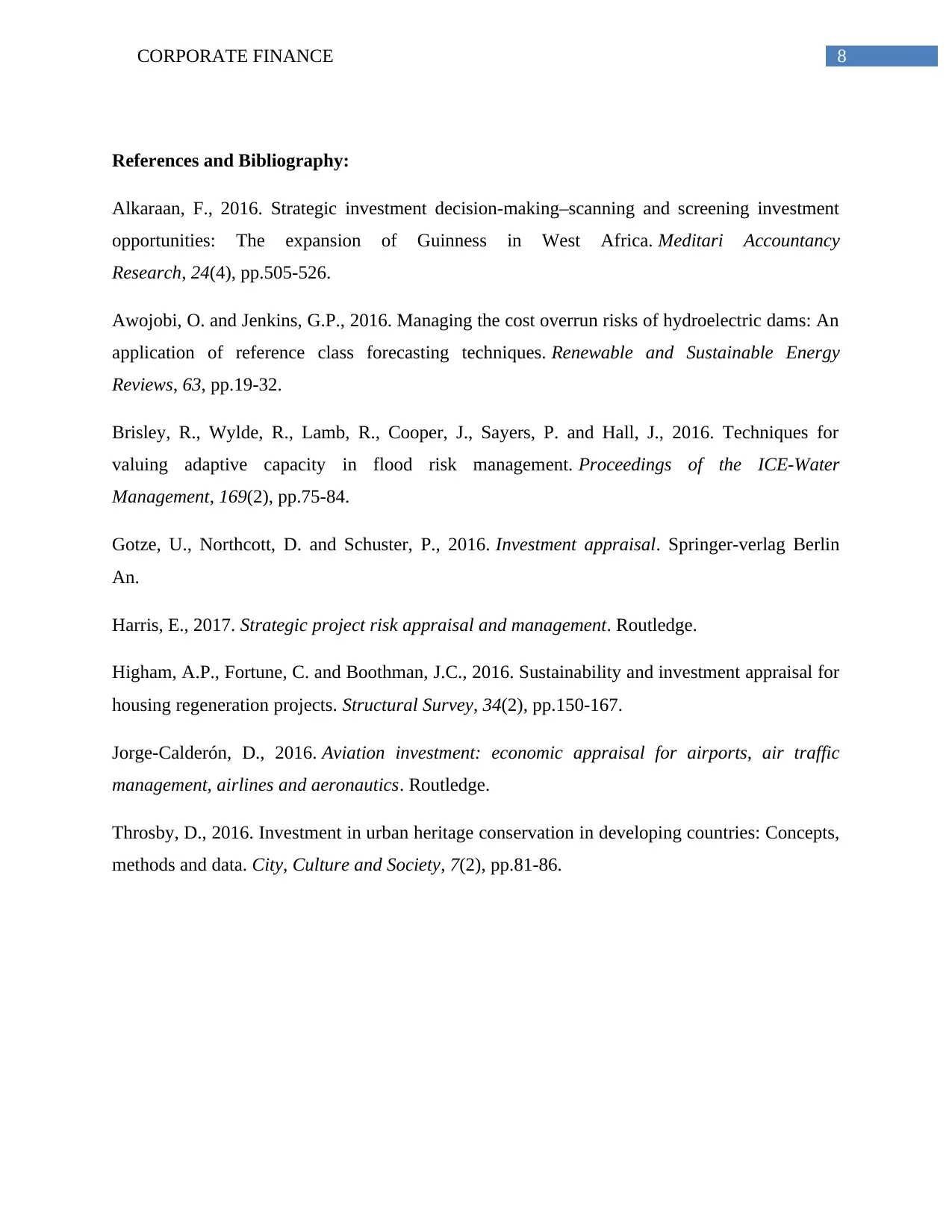
8CORPORATE FINANCE
References and Bibliography:
Alkaraan, F., 2016. Strategic investment decision-making–scanning and screening investment
opportunities: The expansion of Guinness in West Africa. Meditari Accountancy
Research, 24(4), pp.505-526.
Awojobi, O. and Jenkins, G.P., 2016. Managing the cost overrun risks of hydroelectric dams: An
application of reference class forecasting techniques. Renewable and Sustainable Energy
Reviews, 63, pp.19-32.
Brisley, R., Wylde, R., Lamb, R., Cooper, J., Sayers, P. and Hall, J., 2016. Techniques for
valuing adaptive capacity in flood risk management. Proceedings of the ICE-Water
Management, 169(2), pp.75-84.
Gotze, U., Northcott, D. and Schuster, P., 2016. Investment appraisal. Springer-verlag Berlin
An.
Harris, E., 2017. Strategic project risk appraisal and management. Routledge.
Higham, A.P., Fortune, C. and Boothman, J.C., 2016. Sustainability and investment appraisal for
housing regeneration projects. Structural Survey, 34(2), pp.150-167.
Jorge-Calderón, D., 2016. Aviation investment: economic appraisal for airports, air traffic
management, airlines and aeronautics. Routledge.
Throsby, D., 2016. Investment in urban heritage conservation in developing countries: Concepts,
methods and data. City, Culture and Society, 7(2), pp.81-86.
References and Bibliography:
Alkaraan, F., 2016. Strategic investment decision-making–scanning and screening investment
opportunities: The expansion of Guinness in West Africa. Meditari Accountancy
Research, 24(4), pp.505-526.
Awojobi, O. and Jenkins, G.P., 2016. Managing the cost overrun risks of hydroelectric dams: An
application of reference class forecasting techniques. Renewable and Sustainable Energy
Reviews, 63, pp.19-32.
Brisley, R., Wylde, R., Lamb, R., Cooper, J., Sayers, P. and Hall, J., 2016. Techniques for
valuing adaptive capacity in flood risk management. Proceedings of the ICE-Water
Management, 169(2), pp.75-84.
Gotze, U., Northcott, D. and Schuster, P., 2016. Investment appraisal. Springer-verlag Berlin
An.
Harris, E., 2017. Strategic project risk appraisal and management. Routledge.
Higham, A.P., Fortune, C. and Boothman, J.C., 2016. Sustainability and investment appraisal for
housing regeneration projects. Structural Survey, 34(2), pp.150-167.
Jorge-Calderón, D., 2016. Aviation investment: economic appraisal for airports, air traffic
management, airlines and aeronautics. Routledge.
Throsby, D., 2016. Investment in urban heritage conservation in developing countries: Concepts,
methods and data. City, Culture and Society, 7(2), pp.81-86.
⊘ This is a preview!⊘
Do you want full access?
Subscribe today to unlock all pages.

Trusted by 1+ million students worldwide
1 out of 9
Related Documents
Your All-in-One AI-Powered Toolkit for Academic Success.
+13062052269
info@desklib.com
Available 24*7 on WhatsApp / Email
![[object Object]](/_next/static/media/star-bottom.7253800d.svg)
Unlock your academic potential
Copyright © 2020–2026 A2Z Services. All Rights Reserved. Developed and managed by ZUCOL.





